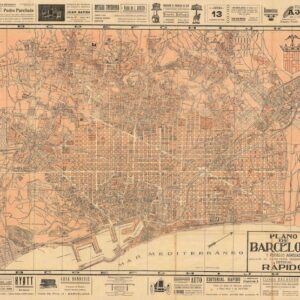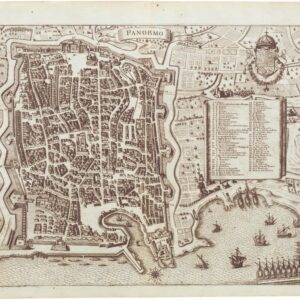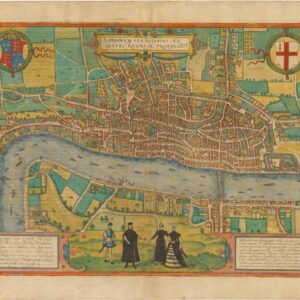Social cartography: a thematic city plan that purports to document the extent and distribution of poverty in New York City in the late 1970s.
Poverty Areas of New York City: Distribution of Public Assistance Recipients by Census Tracts (September 1977)…
Out of stock
Description
This scarce city plan of New York City in the late 1970s is a powerful example of how governments have used cartography to map social dynamics. In this map, published as a revised version of the original in 1980, gridded color coding has been applied to visualize the geographic extent and density of welfare recipients in pre-specified tracts throughout the city.
Four categories have been applied in compiling this map: tracts with more than 1500 welfare recipients are colored a dark yellow; tracts with 1000 to 1499 recipients in orange; tracts with between 500 and 999 recipients in bright yellow; and finally, the tracts with fewer than 500 recipients remain uncolored. The result of this subdivision is a number of pixelated clusters that purport to reveal which neighborhoods in the city suffer the most from poverty. Even a quick glance at the chart reveals that the poorest areas of New York are found around Harlem and in the Bronx, although certain neighborhoods in Brooklyn, Staten Island, Bayswater, and Far Rockaway seem to be trailing closely behind.
The map reflects the situation at the end of the 1970s and much has changed in Greater New York since then (although massive income inequality is not among these changes). A note under the map’s title informs us that it was prepared by The Nova Institute in connection with the restructuring of the New York City Community Action Program and that it was compiled on the basis of data from the NYC City Planning Office. Even though a private institution compiled the map, the data used to meet it was public and the formal issuing entity was Roger Alvarez, Commissioner of the Community Development Agency.
A map with an agenda?
There can be little doubt that the idea behind this work was to map out poverty within the city of New York. The motivation behind this aim was to address the many social problems that the city faced at this time. New York in the 1970s was plagued by violent crime, a collapsing public sector, and abundant social problems. In 1978, Ed Koch assumed control of the mayoral office. By the end of his period in office eleven years later, Koch’s administration had made a serious dent in what might have seemed like insurmountable problems. Under Koch, neighborhoods were rebuilt, urban infrastructure was improved, and crime was reduced. One of the dynamics that supported Koch’s endeavors at the time was the fact that, unlike most American cities, New York experienced steady growth.
Throughout the 1970s and well into the 1980s, crime and homelessness surged alongside real-estate prices. Despite the massive social impact of the Civil Rights Movement, racial tensions had not abated significantly and in New York, violent racial tensions even increased during the 1980s. Today, we talk a lot about the presence of a historical racist undercurrent in American society; a concept that is hard to define tightly and usually is bundled under the term ‘structural racism.’ To what degree one might experience (or even acknowledge) is highly dependent on social and ethnic background. This is exactly why this map is so very interesting and a true testimony to the era in which was created.
When Koch took office in 1978, something needed to be done about the city’s social problems. In fact, a lot needed to be done, and if any administration was to try to tackle these enormous challenges, they would have to break it down into smaller, manageable pieces. Using the latest in social theory, this is exactly what was done, starting by breaking the problems into themes. In this map, the focus is clearly on mapping poverty distribution based on the density of welfare recipients. While such an overview is a necessary prerequisite for broaching the issue of poverty, the map – or rather the methodology and principles behind the map – are not without problems. And looking back, one might argue that the map casts certain people in certain neighborhoods as problematic, and thus should be the recipients of the city’s response. This approach nevertheless runs on a series of assumptions that may well reflect some of that ‘structural racism’ that is so difficult to define.
The map uses a statistical ploy that equates the density of welfare recipients directly with the degree of poverty, simplifying matters significantly. Secondly, while gentrification processes may have changed the composition of certain parts of the city over time, the obvious socio-economic eyesores on this map were of course Harlem and the Bronx, both of which were predominantly African-American neighborhoods with low incomes. There is, in other words, a distinct racial undercurrent to this map, even if this was never an express intention. Throughout the world, administrations simplify complex matters with the aim of formulating actual solutions (and selling them politically). Yet in doing so, they can neglect certain groups or promote certain biased perspectives – even if unintentionally.
This map is a great example of how municipalities and governments strive to simplify complex matters so that a single — often political — message can be extracted. If one were to produce this map today, the distribution pattern would look much different, and an argument might be made that the situation had improved. But the changes incurred would in large part be due to the massive demographic shifts of the last 40 years, as well as to the way in which poverty today is recorded and welfare is issued (Misturelli & Heffernan 2008). The degree to which poverty itself has dropped in New York City over the last forty years, as well as the degree to which the demography of such poverty has changed in that period, is perhaps more questionable.
Census
No copies of this map are recorded in OCLC.
Cartographer(s):
Condition Description
Folding map. Paper a bit toned, very good.
References
Misturelli, Federica & Heffernan, Claire (2008). What is poverty? A diachronic exploration of the discourse on poverty from the 1970s to the 2000s. European Journal of Development Research 20: 666-684. DOI: 10.1080/09578810802464888.

![[Milan and environs]](https://neatlinemaps.com/wp-content/uploads/2019/09/NL-00266-1_r-scaled-300x300.jpg)
![[Milan and environs]](https://neatlinemaps.com/wp-content/uploads/2019/09/NL-00266_r-scaled-300x300.jpg)
![[Milan and environs]](https://neatlinemaps.com/wp-content/uploads/2019/09/NL-00266-cover-2_r-scaled-300x300.jpg)
![[Milan and environs]](https://neatlinemaps.com/wp-content/uploads/2019/09/NL-00266-cover_r-scaled-300x300.jpg)

